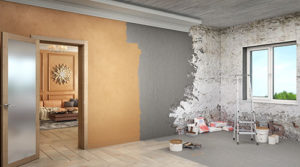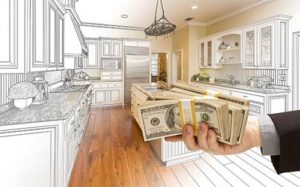Whole Home Remodeling
 U.S. homeowners spend more than $300 billion a year on renovations and repairs. Are you tired of the outdated look of your house? Or maybe you want to give your personal touch! Perhaps the changing family structure has you longing for some more space!
U.S. homeowners spend more than $300 billion a year on renovations and repairs. Are you tired of the outdated look of your house? Or maybe you want to give your personal touch! Perhaps the changing family structure has you longing for some more space!
Whatever it is, the easiest and cost-friendly option is to renovate your home to fit your current needs and vision. What starts with one room can easily spill into the entire house, making it overwhelming for the homeowner.
We bring you everything you need to know about whole home remodeling, including the steps, costs involved, hidden costs, order or renovation, how to cut costs, and much more.
What Is Whole Home Remodeling?
Whole home remodeling allows you to create the home of your dreams without having to buy a new house. It is the process of changing the functionality and design by reconfiguring the layout, including tearing down walls, etc.
While home remodeling often denotes significant changes such as constructing an addition, it can also be as simple as altering the purpose of the area, like converting a guest bedroom to be a home office.
Time Taken for Whole House Renovation Project
A whole-house renovation project can take anywhere from 3 months to 9 months. But the timeline may vary depending on the size, scope, and complexity of the project.
Few days to 3 months – Cosmetic changes like painting and new appliances
Several weeks to 6 months – Medium changes like adding a new fireplace to the living room or a garage to the side of your house
Six months to 1 year – Major foundation or structural repairs and building a new story
Which Is Cheaper: Remodeling or Building a New House?
The cost of tearing down and rebuilding is at least 20% higher than a whole house remodel. So, it might not work if you are on a budget. However, if you are planning to sell it at some point but not in the near future, you may want to tear down and build a new house.
It also depends on the extent of renovation you have to undertake. If you have to refurbish a room or two, replace flooring or repaint walls remodel is your option. However, if you have issues with the foundation, electrical, and plumbing, you may want to build anew.
There are other factors that come into play, such as housing prices, financial capabilities, etc.
What Comes First in Home Remodeling?
Home remodel, however big or small, is a huge undertaking. There is a lot of work that goes into a renovation, and it takes time to plan and get ahead with the project.
While every renovation is different, the process remains the same. As such, the first step in every home remodel is the planning phase where you:
- Design and organize the layout
- Finalize the budget
- Make a list of remodels to be done
- Choose a contractor
Is Renovating a House Worth It?
Yes! Not only does whole house renovation give you space, but it also offers you better returns, albeit some more than the others. While it can be a good investment, it also depends on the renovation itself.
A full kitchen renovation recoups 59% of the cost and a new master suite 50%. Hardwood flooring regains the most at 106%, followed by a new air conditioning(HVAC) system at 85%.
Can I Renovate My House by Myself?
It is always fun to renovate your house by yourself. If you are willing to dedicate time and get dirty DIY projects can help save the renovation costs. However, if the project is extensive, it can quickly go out of control, and the chances are high that you may not be able to know how to do everything.
The following DIY projects are easy enough for beginners to wet their hands.
- Cleaning the vinyl siding
- Repaint the front door
- Paint the walls
- Apply wallpaper
- Reface your cabinets
- Replace your backsplash
- Upgrade your bathroom
- Change your curtains, shades, etc.
- Refinish old flooring
Keep in mind that even something as simple as building a porch requires permits. You may also want to check with the building codes.
How Much Does it Cost for an Entire House Remodel?
 Remodeling a whole house with three bedrooms costs $20,000 to $100,000. On average, the cost runs up to $15-$60 per square foot.
Remodeling a whole house with three bedrooms costs $20,000 to $100,000. On average, the cost runs up to $15-$60 per square foot.
A low-cost home renovation will cost you $20,000 – $50,000.
It includes:
- Interior Painting
- Exterior Painting
- Basic Flooring
- Baseboards
- Landscaping
A medium home renovation costs $50,000-$100,000 and includes the following:
- Full bathroom remodel
- Full kitchen remodel
- Quality flooring, countertops, and cabinets
Kitchen remodels cost $25,000 while a bathroom $10,000 on average. A high-cost home renovation will include everything of professional quality and also custom projects too. In addition to everything had the above, you can also ask for:
- Electrical, plumbing or sewer lines installed or reconfigured
- Custom cabinets, countertops, range hoods, or similar projects
- Roof
- Windows
The cost may change depending on the square footage, the extent of the home renovation, quality of materials, etc. Moreover, structural changes can also add to the cost of remodeling.
How Much Should I Spend on Renovations?
Basically, you should not spend half the value of your house on a room or two or a remodel that doesn’t increase the ROI. The more you spend on a house renovation, the less your returns will be.
Every home renovation is different and will cost more than you think. Figuring out how much to spend on your renovations is challenging. Here are some guidelines.
- A kitchen renovation should be just 5% -15% of the home’s value while a bathroom about 3% – 7%.
- Look for quality materials that perform well and last long.
- While you can ask the contractor to reduce the labor, do not cheap out on it.
How Often Should You Remodel Your Home?
You should remodel your home every 15 – 20 years.
The frequency of remodeling depends on the following factors.
- The present condition of the house
- The last-remodel
- Age of your home
- Wear and tear-related problems like worn-out tiles, leaking roof, chipped paint, termite infestation, etc.
Steps to Full Home Renovation
Whole-home remodeling is no simple task; It is vast and can get increasingly overwhelming as you move through the stages. There are so many things to consider and tons of decisions to make.
However, taking it step-by-step can make it easy for you to get going and see through to the end:
- Planning: Bring your ideas to fruition and design your home or room.
- Interior Design: Pick a style that would stay through the test of time and last for the years to come.
- Budget: Set aside a budget for your remodeling project. Leave 10%-10% for contingency purposes.
- Contractor: Hire contractors and sub-contractors for electrical, plumbing, woodworks, etc.
- Demolition: Tear down walls, remove the carpet, pull up the wallpaper, etc. Basically, anything that needs to be removed to make way for the new changes.
- Rebuilding: Rebuild the walls, window frames, doors, and any other framework related to the structure.
- Mechanicals: Electrical work, plumbing, gas connections, water utilities, ductwork for HVAC, and anything else that relates to utilities is handled in this step.
- Walls: Insulation and drywall followed by taping, mudding, and sanding to get it smooth and ready for painting
- Flooring: After the walls have been painted, the floors will be installed to prevent drips and spills.
- Cabinets: Any cabinet work will happen in this stage, including new ones or refacing.
- Appliances: Everything from refrigerators, cooking range, and washer dryer to fixtures like sinks, faucets, tubs, etc., will be installed as the final stage.
Remodeling contractors will cover all of these steps and make your dream a reality.
Whole Home Remodeling Basics
Renovating a couple of rooms is entirely different from tackling the entire house. It is a mammoth project which requires dedicated planning, time, and patience.
Here are a few things you need to consider before starting the remodeling project:
- One way to bring down the cost is to tackle a portion of it yourself. If it is easy enough, you can do the entire thing yourself.
- How are you financing the project? Home equity loans and equity line of credit are some of the funding options.
- Ensure that the resale value is not affected by the remodel. Most often than not, you will be selling before you finish paying the mortgage.
- Building permits take notoriously long to get approved. Ensure that you are applying well in advance.
- From the interior designer fees to the commission for the contractor, the hidden costs can increase the final bill.
- Renovations inadvertently come with the construction mess, which needs to be tackled carefully. Keep an eye out for lead-based paints.
- Get comfortable with the work crew and build a relationship since you will be interacting with them for the better part of the next few months.
What Should I Renovate First?
Start with checking if the structure is sound and ensuring that the house wouldn’t collapse on you and is no impacted by the renovations.
Here are the more critical concerns that you may want to tackle first:
- Roof repairs/replacement
- Secure the foundation
- Foundation repair such as weakened walls/beams/joists
- Repair damages windows and replaces if needed
- Repair/replace damaged siding to prevent water infiltration.
Once the repairs are complete, begin with the large projects since they will have other dependents and may take time.
Tips for a Successful House Remodel
 How tempting is it to skip to the more exciting parts like paint colors? But for the remodel to go smoothly, you need to follow the below tips:
How tempting is it to skip to the more exciting parts like paint colors? But for the remodel to go smoothly, you need to follow the below tips:
- What is the end goal of the project? Is it increasing the value of the home or adding to the square footage? Or maybe you just want to make the space more comfortable to live in.
- Set a budget and ensure that you stick to it. Also, set aside a contingency fund for unexpected/ hidden costs.
- Do your homework. Talk with your family, neighbors, and friends about the remodel work and the challenges that arise in the due process.
- Ask your contractors for their experience, license, insurance, references, and payments before granting them the contract.
- Pack up and move your belongings away from the renovation zone. Consider renting storage if you are planning on renovating the complete home.
- Ensure that the work happens according to your routine with minimal distractions to your day-to-day activities.
- Plan ahead for utility(electricity and water) outages during the plumbing and electrical work.
- Create a renovation-free area for the family to relax at the end of the day.
- Make time for clean-up at the end of the day. Moving the clutter at the day prevents further delays, lost tools, and more.
- If you plan on a DIY, get help from family and friends for the challenging and difficult tasks. With appropriate support, you can get the work down quite fast.
- Keep an eye on the weather forecast. The last thing you want is the weather disrupting the project. Ensure the exterior work is on a relatively mild day.
Home Remodeling Projects That Add Most Value
Not all home remodeling projects increase the resale value. Hence it is imperative to know the home remodels that add the most value to the selling price.
- Replace vinyl siding with stone veneer – 95.6%
- Replace siding with new fiber-cement – 77.6%
- Minor kitchen remodel – 77.6%
- Replace vinyl siding – 74.7%
- Replace light vinyl windows – 72.3%
- Converting an attic to a bedroom – 70%
- Replace garage doors – 94.5%
Checklist for Renovating a House
Here’s the ultimate checklist for renovating your house. It gives you an idea of what needs to be completed and also helps you plan for the same.
- Exterior (roof, paintwork, siding, door, windows, and the garden.)
- Floor plan and layout. Make sure you obtain the necessary permits.
- Appliances (air conditioning, fridge, dishwasher, cooking range)
- Electrical work (general wiring, lighting, switches)
- Flooring (hardwood, carpet, tiles, rugs, underfloor heating, etc.)
- Plumbing (pipes, sewer system, fixtures)
- Decor and Aesthetics (furnishings, decorations, wall art, paint, fittings)
How to Save Costs On a Home Remodeling Project
Remodels need not be expensive affairs. With a little thought, you can save cost yet remodel tastefully. Here are a few tips for managing a home remodeling project even with limited funds.
- Stick to your budget. Opt for less expensive materials wherever possible and make necessary adjustments.
- Shop for a contractor. Ensure that they have been in the business for a long time and have the liability and worker’s compensation insurance.
- Replace your glass windows with insulated windows. It helps reduce heating/cooling costs and also reduces sound.
- Do not change plumbing locations. Since they are located inside the walls, access is challenging.
- Mid-range cooking appliances are great; And save money for cabinets and countertops.
- Look for more natural options for lighting, like a skylight. Not only do you save on electricity bills, but also you need not restructure your windows.
- Buy new cabinets or appliances only if you need them. Reuse wherever you can.
- A balance between expensive and low-end materials; Door handles and frequently used fixtures should be top-of-the-line and durable. And save cost on less frequently used fixtures.
- Purchase your electronics during Black Friday sales, appliances on American holiday sales, and outdoor furniture during the end-of-summer sales. Research the best time for your purchase.
- If your cabinets are in good condition, reface them with a new coat of paint instead of replacing them.
- Have your contractor design a temporary kitchen and save on eating out.
Hidden Costs of Home Remodeling
The cost of remodeling is never the same as the estimate. Do not be shocked if the final bill is higher than the initial bid.
Here are the common hidden costs:
- 95% of the hidden costs come from change orders that are beyond the scope of the work. Changes always cost extra.
- Unplanned structural changes increase your budget by 10%-15%.
- Bringing your home, especially if it’s older) up to the current building code is not usually factored in the estimate.
- The utility bills may increase if any equipment runs 24/7.
- Unforeseen pest damages, rots, and water damages account for hidden costs.
- Considering the safety of your parts, you may want to think about boarding them for the duration of the project.
The Most Expensive Parts of Home Remodeling
 Remodels are a must if you are to maintain the integrity of the house. Not all rooms cost the same to remodel. Some do not cost as much, while others like kitchen and bathroom hurt your budget a little too much. Even though you’d have to bite the bullet and get it done, the knowledge can help budget and plan accordingly.
Remodels are a must if you are to maintain the integrity of the house. Not all rooms cost the same to remodel. Some do not cost as much, while others like kitchen and bathroom hurt your budget a little too much. Even though you’d have to bite the bullet and get it done, the knowledge can help budget and plan accordingly.
Kitchen
While the cost of renovating the kitchen depends mainly on the materials and the size, it is still one of the most expensive parts of a remodel. However, you get a fantastic ROI of 80%-85% and often worth the money spent on it. The cost can range from a few thousand to $25,000, $50,000, and even more.
Bathroom
The national average bathroom remodels cost is $16000. However, you can reduce the costs by going for inexpensive finishes, tiles, etc. But cannot skimp on the labor costs, which is 4% of the total expenditure. You need experienced personnel to tackle the plumbing work.
New Roof
The average lifespan is around 20 years for asphalt shingles, wood shakes 30 years, and fiber cement shingles 25 years. Tile, slate, and copper roofs can last more than 50 years.
The above stands true if you maintain the roof periodically and adequately fix any problems that arise.
Replacing a roof requires a professional, and the cost will range between $2,000 and $8,500 for 2,200 square feet. You can save the cost by only remodeling a portion of it then replace the entire roof.
HVAC
Be prepared for HVAC systems to eat into your budget, especially if you made new additions as a part of your remodel. You may need larger rooms to cool/heat your home efficiently.
Add/Repair a Garage
Rather than being a space to store your vehicle, a garage is also used as storage or sometimes a studio. The garage costs around $40 per square foot.
Replace Siding
Replacing a siding is an expensive affair and can cost you $7,000-$8,000 on average, depending on the materials, stucco, brick, wood, and stone. They usually require very little maintenance and last a long time, 10 – 50 years.
Can You Remodel a House for $100,000?
A $100,000 gives you plenty of leeways to design your home the way you want. Here are a few home improvements that you can get done with your rather large budget:
- State-of-the-art kitchen with engineered stone countertops, custom wood cabinets, double sink, and a large island in the middle.
- An entertainment area with built-in bookshelves and space to hold the TV and stereo equipment
- Basement remodel with a game room (air hockey, pool table, foosball) and home theatre room.
Conclusion
There’s nothing more beautiful than watching your vision come true as the remodel comes to an end. But the stress is insurmountable.
There are a lot of steps that go into a remodel. From planning to execution, contractors bring your dream to reality. They can work with you every step of the way and help you in all aspects of remodeling.
Your contractor will probably involve subcontractors to finish the technical aspects of the project. Other people who are likely to be involved are interior designers, carpenters, plumbers, electricians, flooring installers, to name a few.
If you plan on a DIY remodel, get ready for weeks, if not months, of chaos and work.
 Assurance Builders was founded in 1998 with a commitment to provide our clients a personal and enjoyable home improvement experience. By offering professional workmanship and quality products, Assurance Builders has earned a reputation for excellent work and quality service. If you are planning to remodel your home, contact Assurance Builders for your FREE quote today!
Assurance Builders was founded in 1998 with a commitment to provide our clients a personal and enjoyable home improvement experience. By offering professional workmanship and quality products, Assurance Builders has earned a reputation for excellent work and quality service. If you are planning to remodel your home, contact Assurance Builders for your FREE quote today!